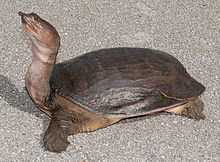Florida softshell turtle
| Florida softshell turtle | |
|---|---|
 | |
| Conservation status | |
| Scientific classification | |
| Kingdom: | Animalia |
| Phylum: | Chordata |
| Class: | Reptilia |
| Order: | Testudines |
| Suborder: | Cryptodira |
| Family: | Trionychidae |
| Genus: | Apalone |
| Species: | A. ferox |
| Binomial name | |
| Apalone ferox (Schneider, 1783) | |
| Synonyms[2] | |
| |
.jpg)
The Florida softshell turtle (Apalone ferox) is a species of softshell turtle native to the Southeastern United States.
Geographic range
It is found primarily in the state of Florida, but it also ranges to southern sections of South Carolina, Georgia, and Alabama.[3]
Description
The Florida softshell turtle typically has a dark brown to olive green, leathery carapace with a white or cream-colored underside,[4] which visually conceals young turtles from potential predators.[5] It has a long neck and an elongated head with a long snorkel-like nose. It is the largest soft-shell turtle in North America, reaching about 15–76 cm (5.9–29.9 in) in length.[4] The female is larger, with the average male reaching only about 35 cm (14 in). The female can weigh up to 20 kg (44 lb), with the record weight documented at 43.5 kg (96 lb).[1] The juvenile is olive-yellow with grey spots and yellow lines. There are also yellow and orange markings on the head and the plastron is gray. The markings disappear or fade as it ages.[4]
Behavior
The turtle is almost entirely aquatic, only emerging from the water to bask or to lay eggs.[4] It prefers the still waters of ponds, streams, lakes, and swamps. Like all soft-shells it is very fast-moving in water and on land.[4] This species is carnivorous, consuming fish, insects, crustaceans, and molluscs. It may also scavenge.[1]
Ecology
Alligators have been known to prey on the adult turtle. Raptors may take juveniles. Nest predators include the Fish Crow, foxes, raccoons, and skunks.[1]
References
- ↑ 1.0 1.1 1.2 1.3 van Dijk, P. P. 2011. Apalone ferox. In: IUCN 2013. IUCN Red List of Threatened Species. Version 2013.1. Downloaded on 21 July 2013.
- ↑ Fritz, U.; P. Havaš (2007). "Checklist of Chelonians of the World". Vertebrate Zoology 57 (2): 305–306. ISSN 18640-5755. Archived from the original (PDF) on 2010-12-17. Retrieved 29 May 2012.
- ↑ Apalone ferox (Schneider, 1783). USGS.
- ↑ 4.0 4.1 4.2 4.3 4.4 Apalone. www.tortoise.org
- ↑ Heron tries to swallow turtle for dinner. Daily Telegraph, 18 Dec 2009.
External links
- Apalone ferox, The Reptile Database
| Wikimedia Commons has media related to Apalone ferox. |
| |||||||||||||||||||||||||||||||||||||||||||||||||||||||||||||||||||||
| ||||||||||||||||||||||||||||||||||||||||||||||||||||||||||||||||||||||||||||||||||||||||||||||||||||||||||||||||||||||||||||||||||||||||||||||||||||

